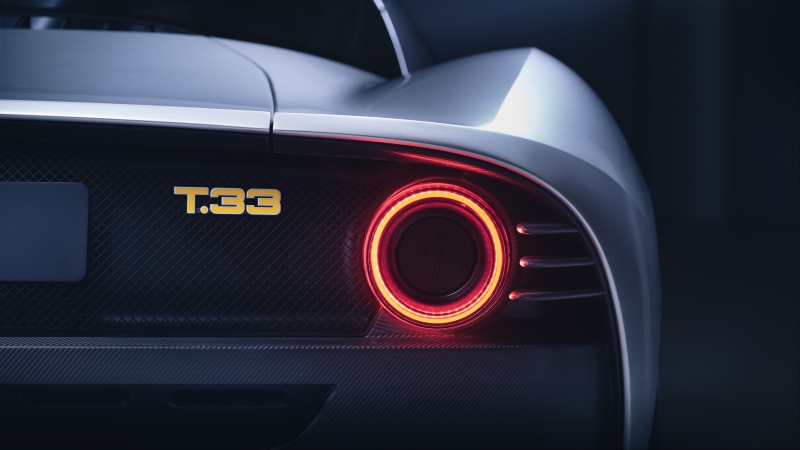It is a rare luxury that we ever get to do the things we want to do. So, Gordon Murray can count himself lucky, as he has got to create a car that isn’t another “McLaren F1”. His latest creation, the GMA T.33, isn’t another “ultimate racecar engineering showcase” halo car. It only seats two abreast, like a conventional supercar. But it is something more personal to its creator.
Recapture the beauties of the Sixties

Ever since he started work on the McLaren F1, the 75-year-old engineering maestro wanted to create a car with the pure aesthetics of the sports cars of his formative years in the 1960s. And one doesn’t need to squint to see that inspiration ebb from the GMA T.33 sensuous and faultless shape.
GMA presents Murray’s personal De Tomaso Vallelunga as the T.33’s muse, with little mention of other sources of inspiration. Though, classic car fans can easily spot familiar shapes from the likes of the Alfa Romeo Tipo 33 Stradale.

Nevertheless, the GMA T.33 looks like an original handiwork from designers straight out of the Sixties. Even the interior is devoid of touchscreens and utilises rotary and analogue controls. Yet, the whole looks put together with the precision and finesse that only a space-age factory could achieve.
It is also small and, in typical Murray fashion, extremely lightweight. At 4.4-metres in length, it is nearly the size of a Porsche 718 Boxster. And at 1090kg, it is just 100kg heavier than the T.50 and lighter than any factory road-legal car with 450kW.

Sadly, GMA will only be producing 100 examples of the T.33, with another two more variants in the works. With each priced at – near as makes no difference to the rest of us – £1.4 million. However, numbers are possibly the least interesting part of the GMA T.33. With anything from Gordon Murray, the car’s engineering is what we are here to hear.
GMA T.33 engineering ingenuity

Murray insisted that the T.33 does not look like the retro facsimile Lamborghini and Ferrari are hawking nowadays. And very much like his engineering ethos, nothing on the GMA T.33 is superfluous. Though devoid of air manipulating extraneous ducts or sculpted flanks, there is plenty of trick aerodynamics underneath.
Inspired by lessons learnt from the T.50, the T.33 adopts a similar aerodynamic design, sans the fan. Despite lacking the T.50’s spinning centrepiece, Murray found that the T.33’s trick ground effects aero still delivers an aerodynamic efficiency that is “30 per cent more effective than a conventional ground effect supercar”.

This meant that the T.33’s downforce-generating rear diffuser ducts is still located close to its centre of gravity. In doing so, the T.33 negates the need for aggressive front aero fitments.
Another aesthetic component of the T.33 is the roof scoop, or to be more accurate, the engine’s ram air intake. Though it looks like part of the body, the roof scoop is separate and mounted directly to the engine. This arrangement eliminates the need for flexible coupling to compensate for the engine vibrations.

In addition to that, Murray says the tiny separation between the intake and body surface has an aero benefit. This gap siphons away a boundary layer of slow-moving air, allowing a cleaner flow of air. In effect, allowing the design team to use a smaller, less conspicuous intake.
Tweaked for driveability

T.50 fans rejoice, as the GMA T.33 will use a variation of its Cosworth-developed 3.9-litre naturally-aspirated V12. Specified as the GMA.2 with yellow cam covers, the V12 produces 452kW at 10,500rpm and 451Nm at 9000rpm. That’s 35Kw and 15Nm less than what it could do in the T.50. Not to mention its peak revs have been pegged back by 1000rpm.
There is a good reason for the change. Murray says that the 12,000rpm V12 in the T.50 was “getting right up there on the ragged edge”.

Instead, the GMA.2, with its new camshafts, valve timing, engine mapping, and exhaust system is designed to be more driveable. Despite the high peak torque engine speeds, 75 per cent of peak torque is available from 2500rpm. Incredible still, is that the engine dispenses 90 per cent of its torque from 4500rpm to 10,500rpm.
As expected, that V12 is paired to a six-speed manual derived from the T.50’s Xtrac-developed unit. On top of that, GMA will offer an optional paddle-shift unit designed around Xtrac’s high-performance Instantaneous Gearchange System (IGS). Unlike dual-clutch gearboxes, Xtrac’s IGS allows two consecutive gears to be selected and engaged simultaneously while channelling drive through one.

Another interesting engineering detail on the T.33 is its innovative rear-hinged side luggage compartment lid on both its rear flanks. Reluctant to divide the single-piece rear quarter panel, Murray made the whole thing a single for the luggage compartment.
An emotional masterpiece

All in all, the GMA T.33 – like the T.50 – is a marvellous piece of automotive design. It might not have a centre seating position like all of Murray’s famous creations, but that was never the intent.
As a work of passion, the T.33 drips with more heart and emotion than the T.50. It is a true return to your roots work of art. A revival of a bygone era’s magic and a melding of the present. It is a product of what a single mind and driving force could achieve in this industry. And we need more of it now, more than ever.

